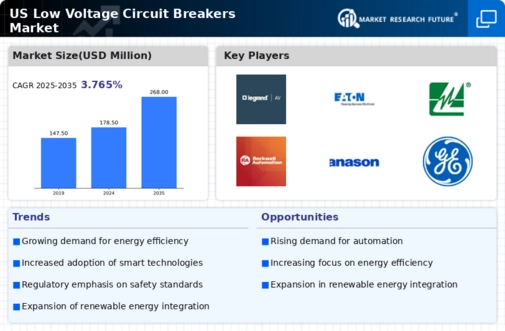Growing Focus on Safety Standards
The low voltage-circuit-breakers market is significantly influenced by the increasing focus on safety standards within the electrical industry. Regulatory bodies and industry organizations are continuously updating safety regulations to mitigate risks associated with electrical failures. This heightened focus on safety is prompting manufacturers to enhance their product offerings, ensuring compliance with the latest standards. The US electrical safety market is projected to grow by approximately 6% annually, reflecting the importance of safety in electrical installations. As a result, the demand for reliable low voltage-circuit-breakers that meet stringent safety requirements is likely to rise, further driving market growth.
Rising Demand for Energy Efficiency
The low voltage-circuit-breakers market is experiencing a notable increase in demand driven by the growing emphasis on energy efficiency across various sectors. As industries and consumers alike seek to reduce energy consumption, the adoption of energy-efficient technologies becomes paramount. This trend is particularly evident in the residential and commercial sectors, where energy-efficient circuit breakers are being integrated into new constructions and retrofitting projects. According to recent data, the energy efficiency market in the US is projected to grow at a CAGR of approximately 8% from 2025 to 2030. Consequently, manufacturers in the low voltage-circuit-breakers market are innovating to meet these demands, leading to enhanced product offerings that align with energy-saving initiatives.
Increased Infrastructure Development
The ongoing infrastructure development initiatives in the US are poised to bolster the low voltage-circuit-breakers market. With significant investments in transportation, utilities, and urban development, there is a heightened need for reliable electrical systems. Low voltage-circuit-breakers are essential components in these systems, providing protection against overloads and short circuits. The US infrastructure market is projected to grow by approximately 5% annually, creating a favorable environment for the low voltage-circuit-breakers market. As new projects emerge, the demand for advanced circuit protection solutions is likely to rise, further propelling market growth.
Expansion of Renewable Energy Sources
The transition towards renewable energy sources is significantly influencing the low voltage-circuit-breakers market. As the US government and private sectors invest heavily in solar, wind, and other renewable energy projects, the need for reliable and efficient circuit protection solutions becomes increasingly critical. Low voltage-circuit-breakers play a vital role in managing the electrical systems associated with these renewable installations. The US renewable energy market is expected to reach $1 trillion by 2030, indicating a robust growth trajectory. This expansion necessitates advanced circuit protection technologies to ensure safety and reliability, thereby driving demand within the low voltage-circuit-breakers market.
Technological Integration in Smart Grids
The integration of smart grid technologies is reshaping the landscape of the low voltage-circuit-breakers market. As utilities adopt smart grid solutions to enhance efficiency and reliability, the demand for advanced circuit protection devices increases. These devices are crucial for managing the complexities of modern electrical networks, which require real-time monitoring and control. The smart grid market in the US is anticipated to grow at a CAGR of around 10% through 2030, indicating a robust shift towards more intelligent energy management systems. This trend suggests that low voltage-circuit-breakers will need to evolve to meet the requirements of smart grid applications, driving innovation and growth in the market.





















Leave a Comment